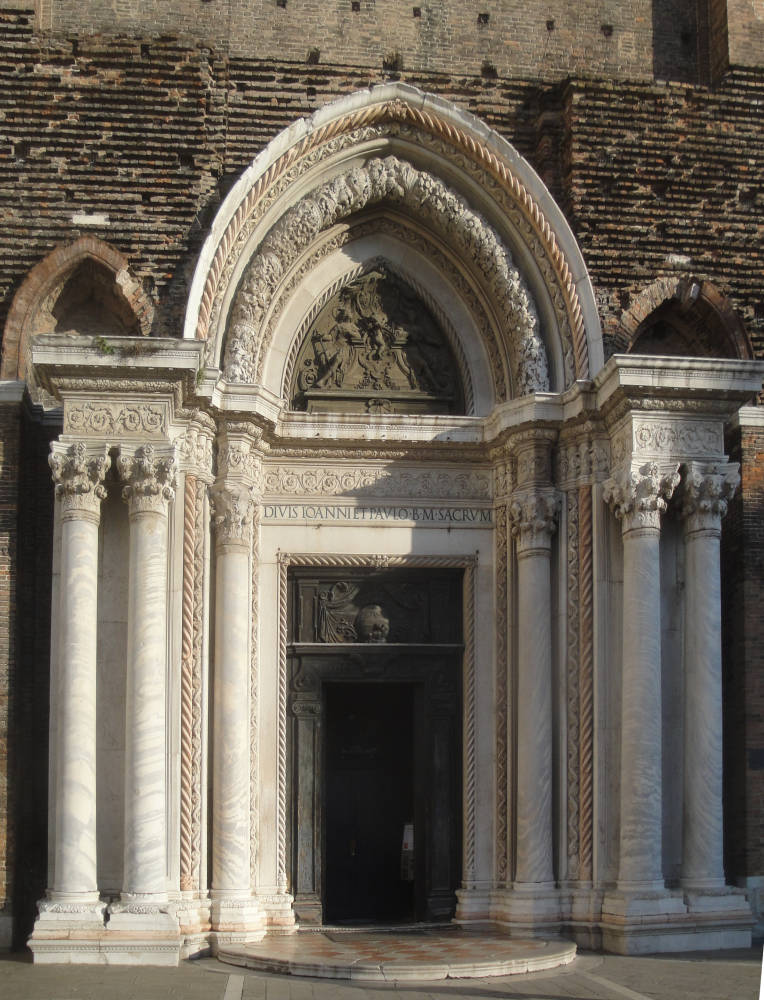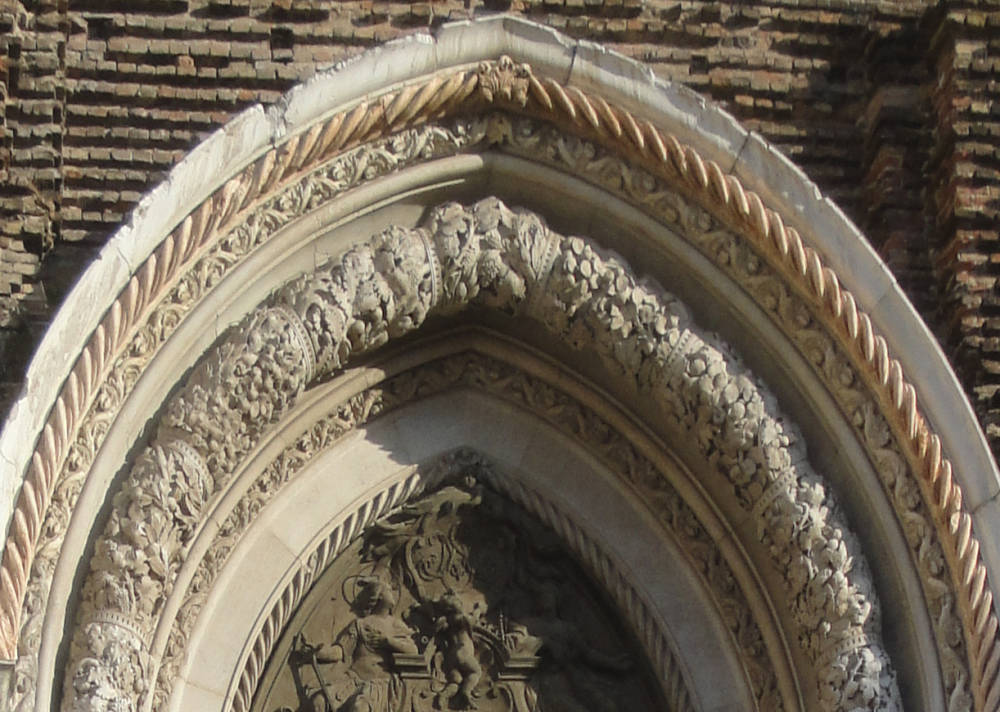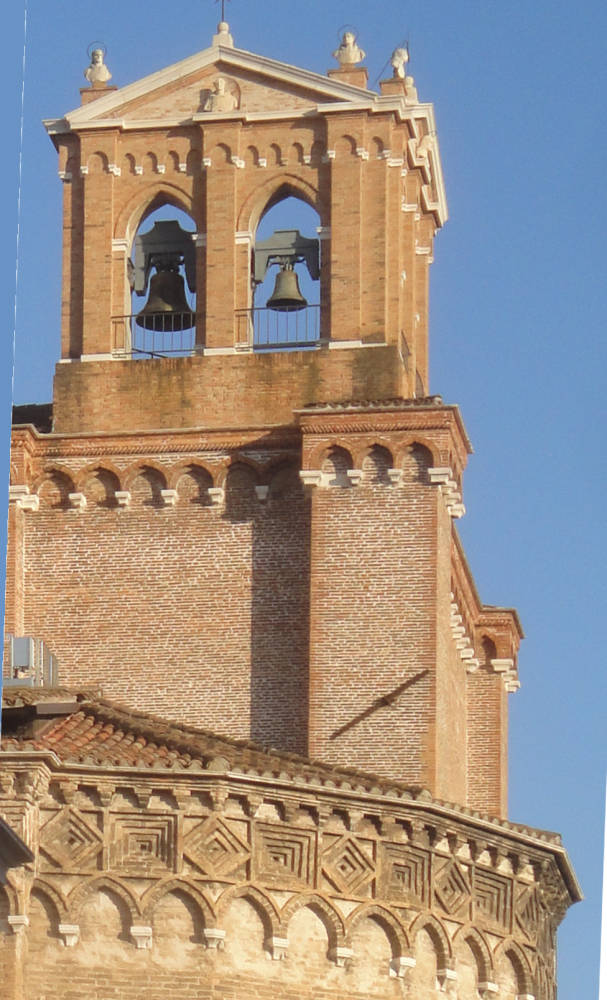
In the chapter entitled “Pride of State” in the third volume of The Stones of Venice, Ruskin explains the origins of the church: “The foundation of the Church of St. John and Paul was laid by the Dominicans about 1234, under the immediate protection of the Senate and the Doge Giacomo Tiepolo, accorded to them in consequence of a miraculous vision appearing to the Doge” in which he saw “the little oratory of the Dominicans, and, behold, the ground all around it (now occupied by the church) was covered with roses of the colour of vermilion, and the air was filled with their fragrance. And in the midst of the roses, there were seen flying to and fro a crowd of white doves, with golden crosses upon their heads.” There’s more: “And while the Doge looked, and wondered, behold, two angels descended from heaven with golden censers, and passing through the oratory, and forth among the flowers, they filled the place with the smoke of their incense. Then the Doge heard suddenly a clear and loud voice which proclaimed, ‘This is the place that I have chosen for my preachers;’ and having heard it, straightway he awoke, and went to the Senate, and declared to them the vision” (11.86). Ruskin points out that there’s nothing miraculous about a “devout Doge” having such a dream, and then there is “the fact, of which there is no doubt, that the greater part of the land on which the church stands was given by him, is partly a confirmation of the story” (11.86). Ruskin adds, “whether the sculptures on the tomb were records of the vision, or the vision a monkish invention from the sculptures on the tomb, the reader will not, I believe, look upon its doves and crosses, or rudely carved angels, any more with disdain; knowing how, in one way or another, they were connected with a point of deep religious belief” (11.86-87).


“The western door is interesting as one of the last conditions of Gothic design passing into Renaissance, very rich and beautiful of its kind, especially the wreath of fruit and flowers which forms its principal moulding.”.


In the tourist guide to Venetian architecture Ruskin included at the end of the third volume of The Stones of Venice, he wrote a particularly long, detailed entry that begins by describing Giovanni e Paolo as “representative of Venetian Gothic” — “An impressive church, though none of its Gothic is comparable with that of the North, or with that of Verona. The western door is interesting as one of the last conditions of Gothic design passing into Renaissance, very rich and beautiful of its kind, especially the wreath of fruit and flowers which forms its principal moulding. The statue of Bartolomeo Colleone, in the little square beside the church, is certainly one of the noblest works in Italy. I have never seen anything approaching it in animation, in vigour of portraiture, or nobleness of line” (11.384).
Ruskin devotes considerable space to describing Tintoretto’s Crucifixion and Our Lady with the Camerlenghi. About the latter he tells us that
As an “Adoration of the Magi,” the picture is, of course, sufficiently absurd; the St. Sebastian leans back in the corner to be out of the way; the three Magi kneel, without the slightest appearance of emotion, to a Madonna seated in a Venetian loggia of the fifteenth century, and three Venetian servants behind bear their offerings in a very homely sack, tied up at the mouth. As a piece of portraiture and artistical composition, the work is altogether perfect, perhaps the best piece of Tintoret’s portrait-painting in existence. It is very carefully and steadily wrought, and arranged with consummate skill on a difficult plan. The canvas is a long oblong, I think about eighteen or twenty feet long, by about seven high; one might almost fancy the painter had been puzzled to bring the piece into use, the figures being all thrown into positions which a little diminish their height. The nearest chamberlain is kneeling, the two behind him bowing themselves slightly, the attendants behind bowing lower, the Madonna sitting, the St. Theodore sitting still lower on the steps at her feet, and the St. Sebastian leaning back, so that all the lines of the picture incline more or less from right to left as they ascend. This slope, which gives unity to the detached groups, is carefully exhibited by what a mathematician would call co-ordinates, the upright pillars of the loggia and the horizontal clouds of the beautiful sky. The colour is very quiet, but rich and deep, the local tones being brought out with intense force, and the cast shadows subdued, the manner being much more that of Titian than of Tintoret. The sky appears full of light, though it is as dark as the flesh of the faces; and the forms of its floating clouds, as well as of the hills over which they rise, are drawn with a deep remembrance of reality. There are hundreds of pictures of Tintoret’s more amazing than this, but I hardly know one that I more love. [11.386]


He closes by listing ten tombs in the church along with the pages in The Stones of Venice where he discusss them in detail (11.387).
More of Ruskin's Venice
- St Mark’s Cathedral
- The Palazzo Ducale, Venice
- The Scuola de San Rocco
- Palazzi
- On the Grand Canal
- Leaving the Grand Canal
- On the way to Venice from the mainland
- Venice: Details and Corners
Photographs 2020. [You may use these images without prior permission for any scholarly or educational purpose as long as you (1) credit the photographer and (2) link your document to this URL in a web document or cite the Victorian Web in a print one.]
Bibliography
Ruskin, John. The Works. Ed. E. T. Cook and Alexander Wedderburn. “The Library Edition.” 39 vols. London: George Allen, 1903-1912.
� �
Last Modified 24 March 2020